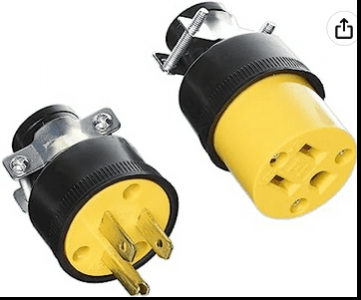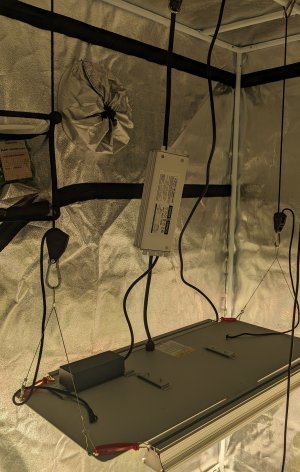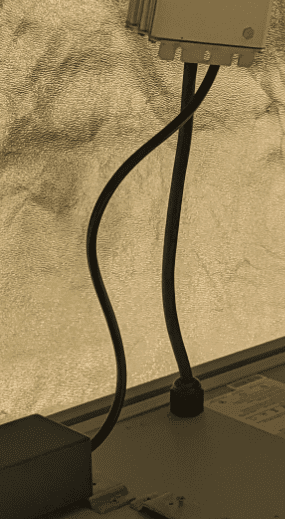How to install the app on iOS
Follow along with the video below to see how to install our site as a web app on your home screen.

Note: This feature currently requires accessing the site using the built-in Safari browser.
You are using an out of date browser. It may not display this or other websites correctly.
You should upgrade or use an alternative browser.
You should upgrade or use an alternative browser.
LED driver wiring
- Thread starter ninjadip
- Start date
-
- Tags
- driver electric led spider farmer
Rootsruler
Know it all
- Joined
- Apr 14, 2023
- Messages
- 3,291
- Reaction score
- 14,707
Can you change out a wall plug? Same idea.....
Your only issue may be that when you open up the driver casing the power leads may be soldered to the board. If not then detach from the driver and replace with the length of cord you desire. The water tight connector it has would be my worry unless you can find another or can remove and reattach to your new cable.
Your only issue may be that when you open up the driver casing the power leads may be soldered to the board. If not then detach from the driver and replace with the length of cord you desire. The water tight connector it has would be my worry unless you can find another or can remove and reattach to your new cable.
Rootsruler
Know it all
- Joined
- Apr 14, 2023
- Messages
- 3,291
- Reaction score
- 14,707
I always discourage splicing power cables. Most don't know how to do it right and fire can ensue. I know this because 2 of my aunts and a cousin died in a house fire for this exact reason.One could cut the wire and splice it with more wire of the same type. I can't see what it is at the top of the picture with the wire going through it, but that might be a good place to add more wire. Is it a switch or a plug or something else?
Anytime I have to replace a power cord for length or it may have gotten damaged I replace with a new one at the length I want rather than splicing in an extender. Every electrician I've spoken to says the same thing. Don't do it.
Can it be done and will it work? Sure. How long? That is the $64,000 question.
A
Amnesia
Guest
Sound advice. It might be easier than opening the cases of both the light and the power supply and soldering in a new cable. The problem is the cable that needs to be lengthened is the one between the light and the power supply, so that would mean opening both devices to do the soldering. One might be able to use connectors instead of splices. I'm not sure what type of connector would be best for that, though. That's above my pay grade.I always discourage splicing power cables.
I would be concerned about suspending the power supply from that carabiner. That was the alarm that went off in my head when I first saw the picture. Factory solders aren't always without flaws.
If it were me, I'd reattach the power supply to the light, leave the factory cable intact and, if more length is needed, I'd use an extension cord. Opening the cases might void the warranty, as well. It also occurred to me that the light might be a heat sink for the power supply.
- Joined
- May 11, 2023
- Messages
- 2,204
- Reaction score
- 9,291
Done it and its easy but you want to seal it after or use an explosion proof connector. Best to replace the entire wire with a new one so no joints are in the tent because of humidity.
Also make sure you have the proper gauge at least 14 gauge from plug to fixture
Also make sure you have the proper gauge at least 14 gauge from plug to fixture
Rootsruler
Know it all
- Joined
- Apr 14, 2023
- Messages
- 3,291
- Reaction score
- 14,707
I was at a build site and watched a guy run an HD 10/3 extension cord with a 16/3 cord spliced into one side. I told him if he was going to splice at least use corresponding gauge. The electricians on site had a wager going to see how long it would take for the guys extension cord to catch on fire.Done it and its easy but you want to seal it after or use an explosion proof connector. Best to replace the entire wire with a new one so no joints are in the tent because of humidity.
Also make sure you have the proper gauge at least 14 gauge from plug to fixture
- Joined
- Apr 16, 2023
- Messages
- 3,242
- Reaction score
- 14,419
Post a clear picture of that driver up close, please.
With properly made connections, splicing is perfectly fine. What it does, however, is add another potential point of failure. With electricity, you want to minimize those. Splices are also easily done incorrectly. I have apprentices I wouldn't trust to do the job you're looking at. Would I, myself, if absolutely necessary? Sure.
With properly made connections, splicing is perfectly fine. What it does, however, is add another potential point of failure. With electricity, you want to minimize those. Splices are also easily done incorrectly. I have apprentices I wouldn't trust to do the job you're looking at. Would I, myself, if absolutely necessary? Sure.
- Joined
- Apr 16, 2023
- Messages
- 3,242
- Reaction score
- 14,419
I've signed an NDA for a particularly large solar company that spent millions of dollars in training and "preventative maintenance" because of a couple relatively serious fires. I will reiterate SPLICES ARE EASILY DONE INCORRECTLYPost a clear picture of that driver up close, please.
With properly made connections, splicing is perfectly fine. What it does, however, is add another potential point of failure. With electricity, you want to minimize those. Splices are also easily done incorrectly. I have apprentices I wouldn't trust to do the job you're looking at. Would I, myself, if absolutely necessary? Sure.
- Joined
- May 11, 2023
- Messages
- 2,204
- Reaction score
- 9,291
That’s understandable and splices on larger cables is definitely not like 12-18 gauge we generally see on lights we use. Im not taking anything away from what your saying but i have hundreds maybe thousands and never seen on burn. I have seen some dumb fucks try to go from 12 to 18 gauge and thats just ridiculous. A splice is always the weak point just as any damage to a cable.I've signed an NDA for a particularly large solar company that spent millions of dollars in training and "preventative maintenance" because of a couple relatively serious fires. I will reiterate SPLICES ARE EASILY DONE INCORRECTLY
As long as the connections are made well, the cable is stripped property (seen many electricians using linesman or cutters) especially on braided wire for what we use here should not really be of any issue. The concern i have is the humidity but even that most of these cheaper fixtures don’t even address from the factory.
Just need to take the time to do it right using the right tools. We also have breakers that will trip if functioning properly…. Imo a light in a grow room should be on a GFI. But almost nobody bothers to even do that
Rootsruler
Know it all
- Joined
- Apr 14, 2023
- Messages
- 3,291
- Reaction score
- 14,707
This is why I recommend those that don't know how to not even chance it.I've signed an NDA for a particularly large solar company that spent millions of dollars in training and "preventative maintenance" because of a couple relatively serious fires. I will reiterate SPLICES ARE EASILY DONE INCORRECTLY
- Joined
- Apr 16, 2023
- Messages
- 3,242
- Reaction score
- 14,419
Yeah that's not a place to get complacent. That's a big boom brother.On a funny note i once watched a journeyman leave an Allen key post to post on 600v panel on installation…. Care to guess how far it flew once energized? Lmao
- Joined
- May 11, 2023
- Messages
- 2,204
- Reaction score
- 9,291
Yeah close to a hundred feet and thank the lucky stars nobody was in that pathYeah that's not a place to get complacent. That's a big boom brother.
Last edited:
- Joined
- Jun 5, 2023
- Messages
- 852
- Reaction score
- 4,984
Yes, you are right. Didn't think about it. Was trying to move the heat off a little. I have the weight supported by a connector that is in a yoyo, but even then I'm sure there is some weight of the driver on the connection. I wonder if I could support it better just a few inches off the light.I would be concerned about suspending the power supply from that carabiner. That was the alarm that went off in my head when I first saw the picture. Factory solders aren't always without flaws.
I have soldering iron, multimeter, shrink tube. But thinking now it's not worth it.I see 4 conductors on the output if I'm reading that right.
What tools are we working with here? Soldering iron? Heat gun? Shrink tube?
You are right. Every thing I would do to it would increase the overall failure rate. I just don't know why it's marketed as a detachable driver when it is such a tight leash. Lol, there it is, marketing. Still might open the driver up and peak my curious nose in.Post a clear picture of that driver up close, please.
With properly made connections, splicing is perfectly fine. What it does, however, is add another potential point of failure.
Thanks everyone, the lights are off now, but I'll have to reevaluate it tomorrow whether I'm going to reattach it or attach another yoyo to have one on each side of the driver or some other way to give it more stability. I'm not stressing for super heat reduction from the canopy, just thought it would be more efficient at cooling if a little separated from board.
- Joined
- Jun 5, 2023
- Messages
- 852
- Reaction score
- 4,984
With my first car I put my hand between two faulty spark plug wires that arced and threw me the fuck back. A big lesson learnedOn a funny note i once watched a journeyman leave an Allen key post to post on 600v panel on installation…. Care to guess how far it flew once energized? Lmao
- Joined
- May 11, 2023
- Messages
- 2,204
- Reaction score
- 9,291
Haha yeah when the insulation wears out from the heat they can give ya a tickle… my last tickle was forgetting to discharge the capacitor on my AC a few years back when replacing it…. Scared the bejesus out of me lol. They hold a charge so even though i had the breaker off i got a little poke to start off the dayWith my first car I put my hand between two faulty spark plug wires that arced and threw me the fuck back. A big lesson learned
Scotty 420
Dank Daredevil
- Joined
- May 3, 2023
- Messages
- 266
- Reaction score
- 1,603
Wow that's crazy! I've changed hundreds of capacitors & never bothered discharging them. I always heard the older techs joking about handing new guys loaded capacitors & watching them shock themselves. I always assumed modern capacitors had some sort of an internal part that automatically discharged them.Haha yeah when the insulation wears out from the heat they can give ya a tickle… my last tickle was forgetting to discharge the capacitor on my AC a few years back when replacing it…. Scared the bejesus out of me lol. They hold a charge so even though i had the breaker off i got a little poke to start off the day
- Joined
- Apr 16, 2023
- Messages
- 3,242
- Reaction score
- 14,419
A nice soldered butt-splice would do the trick. Grab some 14 SO cord and you're golden. Be very careful stripping back the outer jacket on those cables. It can be a pain in the ass.I have soldering iron, multimeter, shrink tube. But thinking now it's not worth it.
my last tickle was forgetting to discharge the capacitor on my AC a few years back when replacing it….
We had a couple hooligans in tech school that would charge them up and hit the unsuspecting. Doesn't take a very big capacitor to get ya through blue jeans. I didn't like that game.Wow that's crazy! I've changed hundreds of capacitors & never bothered discharging them. I always heard the older techs joking about handing new guys loaded capacitors & watching them shock themselves. I always assumed modern capacitors had some sort of an internal part that automatically discharged them.
Pipecarver
POTM Winner
- Joined
- Apr 15, 2023
- Messages
- 2,226
- Reaction score
- 11,270
You could cut the wire in half and add a male and female extension ends. Then once they're put together tape them together to prevent separation & a lose connectionHow hard would it be for me to rewire this driver to be long enough to put outside the tent?
Has anyone else done it?
View attachment 8609

- Joined
- May 11, 2023
- Messages
- 2,204
- Reaction score
- 9,291
I think one of those is for remote and in some cases a potentiometer. Only the power cable would be changedThere are two cables between the power supply and the light. That complicates the project.
View attachment 8771
- Joined
- Apr 16, 2023
- Messages
- 3,242
- Reaction score
- 14,419
That's not gonna get his driver out of the tent, though.I think one of those is for remote and in some cases a potentiometer. Only the power cable would be changed
- Joined
- May 11, 2023
- Messages
- 2,204
- Reaction score
- 9,291
The second one does not plug into anything… its only a foot or so long and as i say no connection so no need to do anything to it unless trying to convert to remote or add a potentiometer…. Im not sure what your saying hereThat's not gonna get his driver out of the tent, though.
- Joined
- Apr 1, 2023
- Messages
- 3,917
- Reaction score
- 22,611
It looks to me that the 4 conductor cable between the driver and the light is the one that needs to be lengthened to get the driver out of the tent. Not the AC which will then be out of the tent with the driver.
Rootsruler
Know it all
- Joined
- Apr 14, 2023
- Messages
- 3,291
- Reaction score
- 14,707
He wants to place the driver outside the tent to reduce any added heat.The second one does not plug into anything… its only a foot or so long and as i say no connection so no need to do anything to it unless trying to convert to remote or add a potentiometer…. Im not sure what your saying here
- Joined
- May 11, 2023
- Messages
- 2,204
- Reaction score
- 9,291
Yes i know that. 4 hrs sleep. No need to increase the power cable then. Just the leads to the lightHe wants to place the driver outside the tent to reduce any added heat.
- Joined
- Apr 16, 2023
- Messages
- 3,242
- Reaction score
- 14,419
I might've misunderstood your reference to the power cable. You must've meant the power cable, between the light and driver, the DC side. That makes sense. Sorry for the confusion Aqua.The second one does not plug into anything… its only a foot or so long and as i say no connection so no need to do anything to it unless trying to convert to remote or add a potentiometer…. Im not sure what your saying here
Similar threads
- Replies
- 16
- Views
- 424
- Replies
- 33
- Views
- 763
- Replies
- 147
- Views
- 5K
- Replies
- 14
- Views
- 891


